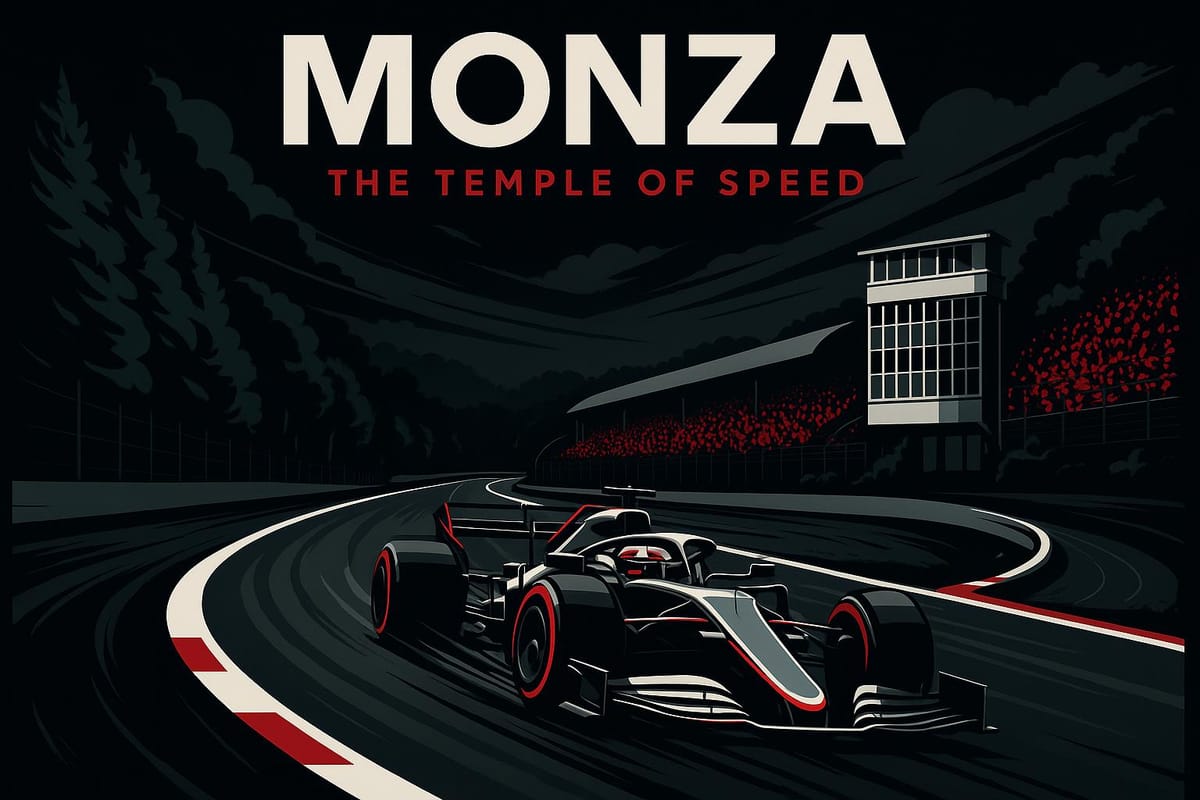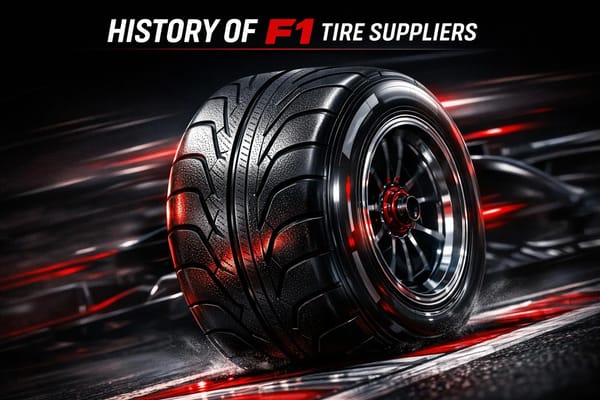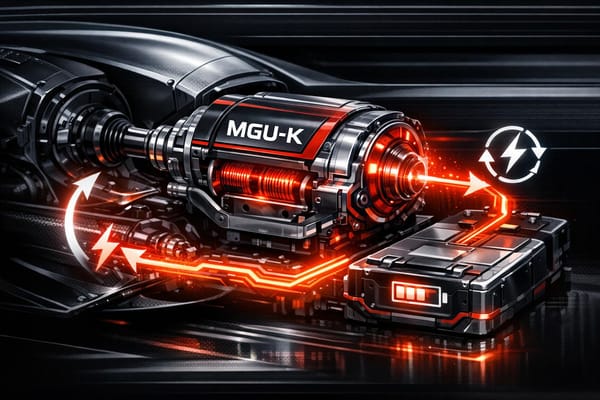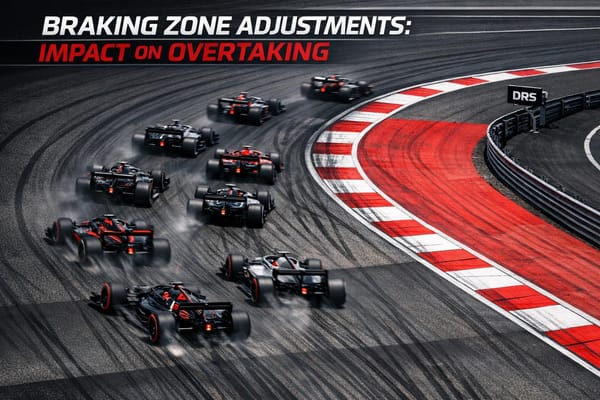Monza’s Temple of Speed: The Fastest Track in F1 and Its Unmatched Heritage
Explore Monza's legacy as Formula 1's fastest track, where history, speed, and the spirit of racing converge in a thrilling motorsport experience.

Monza, known as the "Temple of Speed", is the fastest track in Formula 1 and a cornerstone of motorsport history. Built in 1922, it’s the third-oldest purpose-built circuit globally and has hosted iconic moments, from record-breaking speeds to unforgettable races. Cars reach up to 230 mph on its long straights, with 80% of each lap spent at full throttle. Its design prioritizes speed with minimal elevation changes and tight chicanes, making it a true test of driver skill and engineering precision.
Key highlights:
- Fastest F1 track: Top speeds of 231.5 mph recorded.
- Historic significance: Hosted the Italian GP almost every year since 1949.
- Ferrari’s home: A special connection with the Italian team and its fans.
- Challenges: Demanding braking zones, tire wear, and unique aerodynamic setups.
While recent safety updates have altered some track features, Monza remains a symbol of speed, history, and passion in Formula 1.
Juan Pablo Montoya's record-breaking lap of Monza | 2004 Italian GP
What Makes Monza the Fastest Track in F1
Monza stands as Formula 1's ultimate speed hub, thanks to its unique design and technical features that allow for jaw-dropping velocities. With a layout that has remained mostly unchanged since the 1920s, Monza blends history with engineering challenges, requiring drivers and teams to adopt strategies tailored to its high-speed demands.
Track Layout and Key Features
Monza’s reputation for speed is rooted in its straightforward yet effective design. Unlike the intricate layouts of many modern F1 circuits, Monza prioritizes long straights and tight chicanes, making raw power and aerodynamic efficiency the keys to success. These characteristics demand cars with excellent braking stability and traction.
The circuit's 1.1-kilometer start/finish straight is a prime example, where cars regularly reach their top speeds. But the speed doesn’t stop there. The 3.6-mile track is designed to maximize full-throttle driving, with minimal elevation changes and sweeping curves that allow drivers to maintain astonishing speeds, even in sections considered corners elsewhere. Teams run the smallest wing angles on the calendar to reduce drag, creating cars specifically tuned for straight-line speed. These features not only define Monza’s character but also make it a venue for record-breaking performances.
Speed Records at Monza
Monza’s legacy as a speed temple is backed by numbers. All of the top 50 fastest qualifying laps in Formula 1 history were recorded here, a testament to its unparalleled design.
In 2005, Juan Pablo Montoya, driving for McLaren-Mercedes, hit an incredible 231.5 mph (372.6 km/h), setting the record for the fastest speed ever achieved during a Formula 1 Grand Prix. Rubens Barrichello’s 2004 race lap record of 1:21.046 in the Ferrari F2004 remains another iconic benchmark, showcasing the sustained pace possible at this circuit.
The evolution of F1 technology is also on display at Monza. During the V10 engine era of the mid-2000s, cars reached speeds of around 231 mph (372 km/h). Modern turbocharged hybrid V6 engines, while designed with efficiency and safety in mind, still hit impressive speeds of roughly 224 mph (360 km/h). In 2024, the maximum speed recorded at Monza was 221.9 mph (357.1 km/h), proving that even with today’s stricter safety regulations, Monza continues to push the limits of performance.
High-Speed Racing Challenges
Racing at Monza isn’t just about speed - it’s about managing the unique challenges that come with it. The low-downforce setups required for straight-line efficiency make cars harder to control, especially under braking. To handle Monza’s demands, teams develop specialized aerodynamic packages tailored specifically for its layout.
The braking zones at Monza are among the most punishing in Formula 1. After prolonged periods of high speed, drivers must decelerate sharply to navigate tight chicanes, placing immense strain on braking systems and testing their physical endurance. Tire management is equally critical, as the combination of high speeds and aggressive braking creates unique wear patterns that teams must account for in their strategies.
Another challenge lies in engine performance. With cars running at full throttle for nearly 80% of the lap, power units face extreme thermal stress. Precision becomes non-negotiable when wheels spin at 2,800 RPM, leaving drivers with little room for error. A slight misstep in timing or positioning can result in significant speed losses or even dangerous incidents. The limited run-off areas only add to the intensity, demanding flawless focus from drivers.
These challenges are part of what makes Monza so special. Since 1991, it has consistently held its place as the fastest track on the Formula One calendar, and the unique demands it places on teams and drivers keep it at the forefront of the sport’s most thrilling circuits. The strategies required to conquer Monza will be explored further in the next sections.
Monza's Historical and Racing Legacy
The Origins of Monza
Monza stands as a true icon in the world of motorsport. Constructed in 1922, it became the third purpose-built racing circuit globally, following Brooklands and Indianapolis. Remarkably, the track was completed in just 110 days. Since 1949, Monza has hosted the Italian Grand Prix almost every year, bearing witness to nearly every significant era of Formula One, from the early days of front-engine cars to the cutting-edge hybrid machines of today. Over the decades, it has been a proving ground for racing technology and safety innovations, consistently pushing the boundaries of speed and engineering. These early achievements laid the groundwork for the unforgettable moments that have defined Monza’s place in racing history.
Famous Races and Memorable Moments
Monza's storied past is filled with unforgettable races and milestones. The 1971 Italian Grand Prix delivered the closest finish in Formula One history, with Peter Gethin edging out Ronnie Peterson by a mere 0.01 seconds. In 1988, the circuit became a stage for an emotional victory when Ferrari drivers Gerhard Berger and Michele Alboreto secured a one-two finish shortly after Enzo Ferrari’s passing, ending Ayrton Senna’s McLaren winning streak. Another iconic moment came in 2000 when Michael Schumacher’s victory for Ferrari ended a 21-year championship drought for the team. Schumacher described the scene as a "sea of red" that gave him goosebumps.
Monza has also been a venue for groundbreaking achievements. Sebastian Vettel’s 2008 win for Toro Rosso made him the youngest F1 winner at the time , and Pierre Gasly’s shocking 2020 victory reaffirmed the circuit's reputation for producing surprises. However, Monza's legacy is not without its somber moments. The 1961 crash that killed Wolfgang von Trips and fifteen spectators marked a turning point, leading to the discontinuation of F1 races on the combined oval and road circuit. These defining events have etched Monza into the annals of motorsport history while solidifying its unique identity within Italian racing culture.
Connection to Italy and Ferrari

Monza’s relationship with Ferrari is deeply intertwined with the spirit of Italian motorsport. While Ferrari’s headquarters are in Maranello, Monza is often considered the team’s "home track". Ferrari’s first Italian Grand Prix win at Monza came in 1949, and the team has since claimed 20 victories there, including Charles Leclerc’s electrifying triumph in 2019 . Each race weekend, Ferrari’s loyal tifosi transform the circuit into a vibrant sea of red, creating an electric atmosphere unmatched anywhere else.
Veteran motorsport journalist Pino Allievi captured Monza’s essence perfectly:
"Monza is a very special place. In going there, you go through a tunnel with history. It is different from any other circuit. There is a magnetism you don't get anywhere else."
This connection to Ferrari and Italian motorsport is further highlighted by moments like the 1975 race, where Niki Lauda secured his first World Drivers' Championship as Clay Regazzoni won the race, helping Ferrari clinch the constructors’ title. BBC’s Chief F1 writer Andrew Benson summarized the sentiment well:
"In Italy, Formula 1 means Ferrari. And Monza is where the relationship is consummated."
Set within a royal park surrounded by lush woodlands, Monza isn’t just a racing circuit - it’s a symbol of Italy’s deep passion for speed, engineering brilliance, and automotive artistry. With a capacity of 118,865, it continues to be a cultural treasure that celebrates the heritage and thrill of motorsport.
How Monza Has Changed for Modern Racing
Safety Modifications and Chicanes
Monza has undergone significant changes to meet modern safety standards while striving to maintain its reputation as the high-speed temple of motorsport. A major renovation project, costing around $23 million, included a complete resurfacing of the track and notable adjustments to its iconic chicanes.
One of the more debated changes was the flattening of kerbs at the Rettifilio, Roggia, and Ascari chicanes. The goal was to enhance safety by reducing the aggressiveness of these sections, but many drivers lamented the loss of Monza's distinctive character. The Ascari chicane, in particular, became a lightning rod for criticism. It used to feature unique drainage dips that demanded razor-sharp precision. Alex Wurz, a former F1 driver and chairman of the Grand Prix Drivers' Association, explained:
"It is hard to explain, but the unique kerb Monza had there meant that just a few millimetres' difference in placing the car meant you had understeer or oversteer, because the small water drainage dip grabbed the front tyre or it did not. As a driver you played with that, and man was it cool to nail it."
To discourage corner cutting, narrow gravel strips were added to the runoffs at the first and second chicanes. While these changes aimed to balance safety with fair competition, the reception was mixed. Daniel Ricciardo voiced his disappointment:
"They've changed the kerbs... I can't say I'm that impressed because some elements have lost some of the character of the circuit."
Modern F1 Car Requirements at Monza
These updates have forced teams and drivers to rethink their approach to Monza. Car setups and strategies have had to adapt to the altered dynamics of the track. Data from FP1 in 2024 highlights the impact: Max Verstappen’s minimum speed through the Ascari chicane dropped from 113.7 mph in 2023 to 108.7 mph. The smoother surface and less aggressive kerbs have shifted the balance between aerodynamic efficiency and mechanical grip, compelling teams to recalibrate.
Yuki Tsunoda reflected on the changes:
"It's a smoother, flatter track, flatter kerbs. So it feels like it lost a bit of character of Monza, which maybe might be in a positive or a negative way."
The modifications have also influenced overtaking opportunities. George Russell expressed concerns about the new flat kerbs at Ascari:
"Whereas now they're dead flat, it's going to offer the opportunity for drivers to cut the corner."
These adjustments not only redefine racing strategies but also highlight the ongoing challenge of modernizing historic circuits without diminishing their essence.
Monza's Future in Formula One
Looking ahead, Monza faces the delicate task of balancing its rich heritage with the demands of modern motorsport. Although the recent updates represent a significant investment in the circuit’s future, they’ve sparked debates about how best to preserve Monza’s unique appeal. Future upgrades will need to take into account the lessons learned from the kerb modifications, ensuring that the track remains both safe and thrilling.
A recurring issue is the lack of driver involvement in track changes. George Russell emphasized this point:
"Drivers are often the last to know when track changes occur... there was so much character, with Ascari as an example – I don't think it will be as impressive with the kerb changes."
He also called for a more collaborative approach:
"I honestly don't know who makes these decisions, I don't think it's the FIA, I think it's the circuits themselves... we've always said these old-school circuits with incredible character, you need to preserve that at all costs."
As Formula One evolves with new technical regulations and sustainability goals, Monza must carefully navigate the tension between safety, spectacle, and tradition. The recent changes serve as a lesson for other historic circuits: while safety is non-negotiable, preserving the unique traits that define these tracks is equally important. Monza’s journey exemplifies the balancing act required to keep motorsport’s most iconic venues relevant in a changing world.
Race Strategies for Success at Monza
Achieving success at Monza requires a finely tuned balance between sheer speed and tactical precision. Known as the "Temple of Speed", this legendary circuit demands that teams extract maximum performance on its long straights while maintaining control through its tricky chicanes. Recent track updates, aimed at balancing safety and speed, have only heightened the need for meticulous preparation. From garage setups to on-track decisions, every choice matters when it comes to securing victory at this iconic venue.
Aerodynamic Setup for Maximum Speed
Monza’s layout, dominated by its long straights and relatively few corners, pushes teams to prioritize aerodynamic efficiency. To minimize drag, teams typically run low-downforce setups, which means flattening the front and rear wing angles. While this approach sacrifices some cornering grip, it ensures top-end speed on the straights, which is critical for success at Monza’s high-speed sections.
Finding the right balance is key. Engineers aim to reduce drag without compromising stability, especially through the chicanes. The Drag Reduction System (DRS) zones further amplify the importance of aerodynamics, as they provide crucial overtaking opportunities. Beyond wing adjustments, teams also fine-tune gear ratios to ensure rapid acceleration out of the chicanes, allowing drivers to seamlessly transition from tight corners to full-throttle straights.
Tire Management and Pit Stop Timing
Tire strategy at Monza is a game of balancing speed, durability, and race position. The high speeds and lateral forces on this circuit can lead to graining, making tire management especially challenging. Mario Isola, Pirelli’s Motorsport Director, highlighted the role of temperature in tire performance:
"Temperatures will play an important role. In the race, we should have a situation very similar to the one we had in qualifying, which will not help teams and drivers manage the tires. The risk of graining will be quite present and could lead drivers to change their plans by opting for two stops."
Despite this, Monza’s unusually long pit lane often makes a one-stop strategy the go-to choice for most teams. Isola explained the optimal approach:
"On paper, the very long Monza pit lane usually means that a one-stop is almost obligatory here: so a strategy based on using one set of the C4 and one of the C3, stopping between Laps 20 and 26 is the quickest."
The Medium (C4) and Hard (C3) compounds are typically the preferred choices, with teams carefully managing the early laps of each stint to prevent excessive tire wear. For drivers starting further down the grid, beginning on Hard tires can be advantageous, as the track surface tends to improve as the race progresses. To stay flexible, many teams in 2024 kept two sets of Hard tires available, allowing for a potential two-stop strategy if conditions demanded it.
Isola further noted:
"Honestly, I think everyone will try and run a one-stop, trying to manage the tyres especially in the opening laps of each stint to avoid stressing them too much, while aware they have a Plan B up their sleeve thanks to having two sets of Hard."
Driver Skills and Precision Required
Monza is a true test of a driver’s skill, requiring a combination of bravery, precision, and adaptability. The circuit’s high-speed nature demands masterful control, particularly in the braking zones. Drivers must brake in a straight line and modulate pressure carefully to avoid locking up the tires. Equally crucial is the technique for exiting corners - smooth throttle application and early acceleration can create a significant advantage on the straights.
The chicanes present their own challenges, especially Variante Della Roggia, where drivers must ride the curbs aggressively without unsettling the car’s balance. The quick left-right transitions here test both the suspension setup and the driver’s ability to control lateral weight shifts.
Adaptability is perhaps the most vital skill at Monza. The combination of high-speed straights and technical sections creates constantly shifting demands on both car and driver. Track conditions can change rapidly, tire performance evolves throughout a stint, and slipstream opportunities appear in an instant. Drivers who can process these variables and stay focused at high speeds often have the edge. It’s this blend of technical mastery and strategic thinking that separates the best from the rest at Monza, a circuit steeped in motorsport history and the relentless pursuit of speed.
Conclusion: Monza's Place in Formula One History
Monza is far more than just another stop on the Formula One calendar - it’s a living symbol of high-speed racing heritage. Since its debut in 1922, this iconic track, famously dubbed the "Temple of Speed", has become a cornerstone of motorsport. As the third oldest purpose-built circuit globally and the first in continental Europe, Monza carries nearly a century of racing legacy that continues to resonate in today’s Formula One.
The numbers speak for themselves. Lewis Hamilton’s blistering 2020 pole lap at 164.2 mph (264.362 km/h) and Michael Schumacher’s 2003 record average speed of 153.8 mph (247.585 km/h) highlight Monza’s status as the ultimate test of raw speed. These feats show why Monza remains a proving ground for both drivers and machines, pushing the boundaries of what’s possible.
But Monza’s magic isn’t just about speed; it’s deeply emotional. Ferrari’s 21 victories at their home Grand Prix have cemented an unbreakable bond between the Italian team and its devoted tifosi. Veteran journalist Pino Allievi perfectly captured Monza’s allure:
"Monza is a very special place. In going there, you go through a tunnel with history. It is different from any other circuit. There is a magnetism you don't get anywhere else."
Moments like Charles Leclerc’s 2019 triumph, which ended Ferrari’s nine-year winless streak at Monza, serve as powerful reminders of the circuit’s ability to create defining chapters in Formula One. These moments are why Monza remains integral to the sport’s ongoing narrative.
What truly sets Monza apart is its ability to balance its rich history with the demands of modern racing. Over the decades, the track has undergone changes to improve safety while preserving its high-speed character, ensuring it stays relevant for today’s cutting-edge Formula One cars. It’s a place where history and innovation coexist, delivering the thrill of speed year after year.
Derek Bell, a racing legend, summed it up best:
"If it is the only race you are going to do in your life it has to be Monza. It is something different. It is the high speed, the atmosphere, the history, the oval, all the things that are part of that."
As Formula One continues to grow on a global scale, Monza remains the gold standard for what a Grand Prix should embody - pure speed, a storied past, and an atmosphere charged by the passion of its fans. The Temple of Speed doesn’t just honor its legacy; it actively shapes the future of Formula One. It’s a place where champions are made, records are broken, and the essence of the sport comes alive for fans around the world.
FAQs
Why is Monza’s track layout so challenging for drivers and teams when it comes to car setup and race strategy?
Monza stands out as a track that pushes both drivers and teams to their limits, thanks to its unique layout of long, high-speed straights paired with tight, technical chicanes. The challenge lies in finding the right balance: cars need low aerodynamic drag to hit top speeds on the straights, but they also require enough downforce for stability when navigating the corners. This often means teams opt for minimal aero setups, all while ensuring the car remains manageable.
The track's extreme speeds also take a toll on tires, making tire management a crucial element of the race. Teams have to carefully craft their pit strategies and plan overtaking moves with precision, especially in the chicanes where accuracy is everything. These unique demands turn Monza into a thorough examination of both engineering expertise and driver skill.
How have recent safety updates at Monza changed racing strategies and driver performance?
Recent updates at Monza, including adjusted curbs and resurfaced track sections, have reshaped how drivers approach the circuit. These modifications have shifted the usual racing lines, making overtaking trickier and forcing drivers to refine their techniques on the fly.
The resurfacing has also introduced higher tire wear, pushing teams to reevaluate pit stop strategies and place a stronger emphasis on tire management to sustain performance. While these changes aim to enhance safety, they’ve also brought fresh challenges to race-day planning, influencing both drivers and teams in significant ways.
Why is Monza so important to Ferrari and its fans, and how has their bond with the track grown over time?
Monza, famously known as the Temple of Speed, holds a special place in Ferrari's story and its devoted fanbase, the Tifosi. Just around 125 miles from Ferrari's home in Maranello, this circuit isn't just another track - it's a symbol of tradition and triumph for the team. Over the years, Monza has been the backdrop for some of Ferrari's most unforgettable victories, cementing its legendary status among fans.
What truly sets Monza apart is the electric energy brought by the Tifosi. Their passion fills the grandstands, creating an atmosphere that’s impossible to replicate. For Ferrari, Monza is more than a racetrack - it embodies their racing spirit, Italian pride, and a love for speed. Even today, it remains a vital part of Ferrari's identity and a place where their legacy continues to thrive.
Related posts
- Monaco Grand Prix Circuit Guide: The Prestige, Precision, and Pressure of F1’s Crown Jewel
- Albert Park Uncovered: The History, Evolution, and Challenges of the Australian Grand Prix Circuit
- Suzuka’s Legacy: How Japan’s Iconic Figure-8 Circuit Became a Driver Favourite
- Spa-Francorchamps Deep Dive: The Drama, Danger, and DNA of Belgium’s Legendary Track




